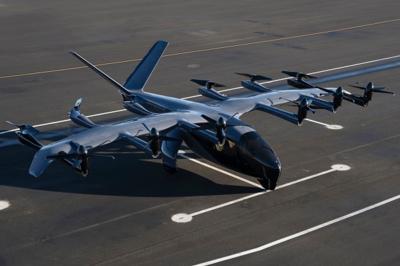Visit Evinces Growing DOD Interest in Midnight eVTOL Platform
Archer Aviation, the California-based designer of electric Vertical Take-Off and Landing (eVTOL) aircraft, showcased its Midnight eVTOL platform to a group of high-ranking U.S. Marine Corps officers.

The USMC’s visit to Archer’s California facilities comes on the heels of 31 July announcement that the eVTOL maker had broadened its working relationship with the U.S. Department of Defense (DOD) by means of a newly-signed $142-million contract under which Archer will provide the U.S. Air Force data pertaining to flight-testing and pilot training, share certification-related test reports, and help the service develop maintenance and repair operations under its AFWERX Agility Prime program—an expansive DOD undertaking in which Archer has participated since 2021.
The Marine Corps’ curiosity vis-à-vis Archer’s Midnight evinces growing military interest in eVTOL aircraft and the tactical advantages ostensibly inherent such contraptions.
U.S. Department of Defense brass have acknowledged the fundamental shift in military aviation operations occasioned, ostensibly, by the Midnight platform’s vertical takeoff and landing capabilities, proprietary electric powertrain, low noise profile, and targeted one-thousand-pound payload.
Such an aircraft promises to enhance rapid-response, agility, and operational effectiveness across a range of mission profiles spanning personnel transport, logistics support, search and rescue, and combat operations.
Archer’s Midnight eVTOL is expected to afford U.S. military services a safer, lower-noise, less-expensive, easier-to-maintain alternative to conventional helicopters.
Retired Two-Star General and Archer government services advisory board-member Clay Hutmacher remarked: “The low-cost, low-noise, high-safety nature of Archer’s Midnight makes it a very compelling aircraft for all branches of the U.S. military to integrate into their fleets. We continue to see increasing interest in the capabilities of eVTOL aircraft across the military.”
General Hutmacher retired in 2018 after serving upwards of forty-years in the U.S. Army, during which he functioned as an Army Special Operations Aviator and commanded at every level during three combat tours with the 160th Special Operations Aviation Regiment. Hutmacher’s last active-duty assignment was Director of Operations in the U.S. Special Operations Command in Tampa, Florida.
Archer is currently working with its government services advisory board to more fully engage with U.S. government and public-safety agencies in hopes of exploring further opportunities to commercialize its Midnight eVTOL aircraft.
On 11 May 2023, Archer completed final assembly of the first full-scale Midnight aircraft and shipped the machine from the company’s Palo Alto facility to its Salinas flight test installation. Component manufacturing is currently underway for Archer’s conforming Midnight aircraft, which the company plans to assemble in 2023’s fourth-quarter.

Painted in broad strokes, Archer’s Midnight is a single-pilot, five-passenger eVTOL aircraft evolved from an antecedent Archer design known as Maker, from which Midnight inherited a flight-architecture comprising 12 electric-motor/rotor assemblies: six five-blade tilt-rotors for forward and vertical flight, and six two-blade fixed-rotors for vertical flight exclusively. The entirety of the aforementioned motor/rotor assemblies are affixed by pylons to a single, high-wing of relatively high aspect ratio. The six tilt-rotor assemblies are positioned forward of said wing, while the six fixed-rotor assemblies are positioned aft of such.
Midnight’s 12 electric motors weigh a miserly 55-pounds apiece and have peak individual power outputs of 125-kilowatts (167-horsepower). The powerplants’ power-to-weight ratio is approximately 3.04-horsepower/pound.
The motors are supplied electrical power by a sextet of proprietary eight-hundred-volt battery-packs comprising cylindrical, type 2170 lithium-ion battery cells provided by the Taiwanese battery manufacturer Molicel. Each of the six battery-packs supplies two motor/rotor assemblies and are interconnected in such a way that load may be varied and individual battery-packs isolated. In addition to providing redundancy in the event of motor or battery failure, the described Distributed Electric Propulsion (DEP) scheme facilitates reductions in power requirements of nearly twenty-percent at the battery cell level—compared to conventional high-voltage battery designs.
So motivated, Midnight attains and advertised cruise speed of 130-knots, a single-charge range of 17 to 43-nautical-miles—dependent upon aircraft loading and flight conditions—and a cruising altitude of two-thousand feet MSL.
Midnight’s ovular-cross-section fuselage sits atop a fixed, tricycle undercarriage; the machine’s empennage is of a V-configuration evocative of Beechcraft’s S-35 Bonanza.
Loaded to its maximum takeoff weight, Midnight tips the scales at seven-thousand-pounds. The aircraft’s maximum payload is nebulously cited as “one-thousand-plus-pounds.”
To mitigate risk, Archer’s engineers provisioned Midnight with a proprietary system by which fire is prevented in the event of thermal runaway secondary to failure of the aircraft’s lithium-ion battery-cells. Archer has yet to disclose the details of its claimed thermal runaway solution, however, Alex Clarabut, Archer’s director of battery systems, averred “if we have a failure of the battery management system, we've got enough redundancy in the system to be able to continue to fly safely.”

Archer’s strategy for Midnight’s deployment is predicated upon an Urban Air Mobility (UAM) model comprising twenty-mile back-to-back routes conducted in rapid succession. As Midnight’s design targets a one-hundred-mile-per-charge range, numerous such legs could be flown by a single aircraft.
For initial UAM operations, Archer will rely on existing infrastructure, such as the Manhattan heliport, which anchors a route to and from Newark; and Vertiport Chicago, a facility that will presently serve as the hub for an air-taxi route between the Midwestern metropolis’s famed downtown Loop and O’Hare International Airport (ORD).
Archer founder and CEO Adam Goldstein opined: “Over time, we will build more infrastructure or work with companies to build more infrastructure.”
 Bolen Gives Congress a Rare Thumbs-Up
Bolen Gives Congress a Rare Thumbs-Up The SportPlane Resource Guide RETURNS!!!!
The SportPlane Resource Guide RETURNS!!!! Buying Sprees Continue: Textron eAviation Takes On Amazilia Aerospace
Buying Sprees Continue: Textron eAviation Takes On Amazilia Aerospace Hawker 4000 Bizjets Gain Nav System, Data Link STC
Hawker 4000 Bizjets Gain Nav System, Data Link STC Echodyne Gets BVLOS Waiver for AiRanger Aircraft
Echodyne Gets BVLOS Waiver for AiRanger Aircraft





